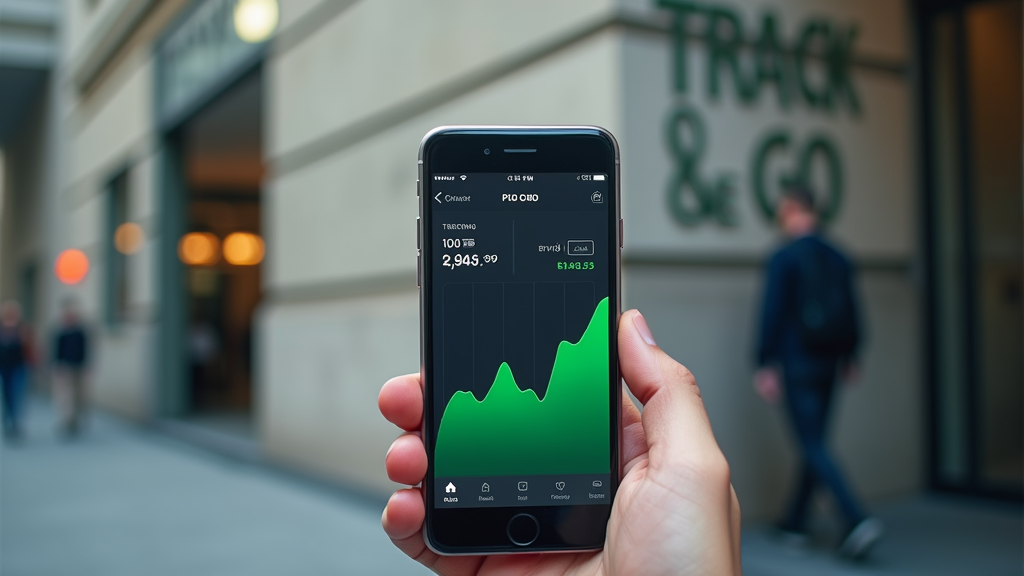
Introduction
Your investment success largely depends on how well you keep track of your stocks. Missing important price changes or dividend payments can cost you money and opportunities. Many investors lose track of their investments because they don't have a good system to monitor their stock positions.
You can start tracking your stocks using simple methods like spreadsheets or modern tools that update automatically. Whether you're new to investing or have been trading for years, you'll find stock tracking basics that work for your needs. We'll look at different ways to monitor your investments, from free tools to professional-grade systems that help you make better decisions with your money.
Understanding Stock Metrics
Stock metrics help you make smarter investment choices. Think of them as report cards for stocks that tell you how well a company is doing and what other investors think about it.
Three basic metrics can tell you a lot about a stock. The Price to Earnings (P/E) ratio shows if a stock might be expensive or cheap compared to how much money the company makes. Market cap tells you the total value of all company shares, helping you know if you're looking at a big company like Apple or a smaller business. Volume shows how many shares other people are buying and selling each day, which helps you understand if many investors are interested in the stock.
These numbers guide your investment choices. A high P/E ratio might mean other investors expect the company to grow quickly. Low trading volume could mean you'll have trouble selling your shares when you want to. Market cap can help you balance your investments between bigger, stable companies and smaller ones that might grow faster.
To start tracking these metrics, pick a few stocks you like and write down their P/E ratio, market cap, and volume once a week. You can find these numbers on free websites like Yahoo Finance or your broker's website. After a few weeks, you'll start seeing patterns that can help you make better choices about when to buy or sell.
Basic Tracking Methods
A stock tracker helps you monitor your investments and potential opportunities. You can start with simple methods like writing down stock prices and important dates in a notebook. This old-school approach works well if you're tracking just a few stocks and want to learn the basics of market monitoring.
Here are the fundamental tools you can use to track stocks:
- Spreadsheets: Programs like Microsoft Excel or Google Sheets let you create custom stock tracking systems
- Stock Screeners: Websites like Yahoo Finance offer free screening tools to filter stocks by price, sector, or performance
- Financial Websites: Popular sites such as MarketWatch provide real-time stock quotes and news
- Mobile Apps: Your phone's app store has many free stock tracking applications you can use on the go
You don't need to use all these tools at once. Start with one or two that match your needs. If you check stocks a few times per week, a simple spreadsheet might be enough. For more frequent trading, you might want a mobile app with real-time alerts. Pick tools that fit your schedule and trading style, then add more as your needs grow.
Setting Up Stock Alerts
Stock alerts help you stay updated on market changes without watching screens all day. You can set them up to notify you about important price changes, news, or unusual trading activity.
Different alerts serve different purposes. Price alerts tell you when a stock reaches a specific value or changes by a certain amount. Volume alerts signal when many people are buying or selling a stock at once. News alerts keep you informed about company announcements that might affect stock prices.
Popular trading apps like Robinhood and E*TRADE let you create custom alerts right in their mobile apps. Most platforms allow you to receive notifications through email, text messages, or push notifications. You can usually adjust how often you get alerts to avoid too many messages while still staying informed about important changes.
Note: Some brokers charge extra fees for real-time alerts. Check your trading platform's pricing details before setting up notifications.

Popular Tracking Platforms
You can track stocks using several online platforms that provide real-time data and analysis tools. The most popular options include Yahoo Finance and TradingView, which offer both free and paid features for investors.
| Feature | Yahoo Finance | TradingView |
|---|---|---|
| Basic Charts | Free | Free |
| Real-time Data | Limited in free version | Limited in free version |
| Premium Cost | $35/month | $15-30/month |
| Mobile App | Yes | Yes |
| Technical Tools | Basic | Advanced |
| News Integration | Comprehensive | Basic |
| Ease of Use | Simple interface | Steeper learning curve |
Your choice of stock tracking apps should match your investment style and goals. If you want simple price tracking and news updates, Yahoo Finance might work best for you. But if you need advanced charts and technical analysis tools, TradingView could be worth the extra cost. Both platforms work well on phones and computers, so you can check your stocks anywhere.
Creating a Tracking System
A well-organized stock watchlist helps you spot good buying opportunities. You can group stocks by industry, market cap, or your personal interest in them. Start with 10 to 15 stocks you want to follow closely. This number lets you stay focused without getting overwhelmed by too much information.
To track stock portfolio performance effectively, create clear categories for your investments. You might sort them by investment goals like growth stocks for long-term gains or dividend stocks for regular income. This setup makes it easier to check if each group of stocks meets your financial plans.
Set up regular times to review your stocks. Many investors check their holdings once a week, while active traders might look several times daily. Pick a schedule that fits your trading style and stick to it. A good practice is to review your stocks at the same time you check other financial matters, like paying bills or planning your budget.
Advanced Tracking Features
Technical analysis gives you powerful tools to understand stock movements. You can spot trends using popular indicators like moving averages and RSI (Relative Strength Index). These tools help you see patterns in stock prices and make better decisions about when to buy or sell.
Automated tracking systems save you time by watching stocks for you. You can set up alerts for price changes, volume spikes, or specific market conditions. When something important happens, you'll get a notification right away. This means you won't miss important market moves while you're busy with other tasks.
Stock analysis tools work better when they pull data from multiple sources. You might want to combine price data with news updates, social media sentiment, and company financial reports. This gives you a fuller picture of what's affecting your stocks. Many platforms let you customize your dashboard to show exactly the information you need.
Widget Bloom's real-time data widgets bring live stock information right into your Notion workspace. You can track multiple stocks at once, see instant price updates, and monitor key metrics without switching between different apps. These widgets work smoothly with your existing Notion setup, making it easier to keep all your stock information in one place where you need it.

Mobile Stock Tracking
Your smartphone can be a powerful tool for watching the stock market. You can check your investments anywhere, make quick trades when needed, and stay updated on market changes right from your pocket.
Several reliable apps help you track stocks on the go. Robinhood offers a clean interface for beginners, while Yahoo Finance provides detailed charts and news. E*TRADE gives you professional-level tools, and Webull includes helpful educational content for new investors.
Setting up mobile notifications keeps you informed about important stock movements. You can get alerts for price changes, breaking news, and market events that affect your investments. Most apps let you customize these alerts based on your preferences, so you won't get overwhelmed with unnecessary updates. Start with a few key notifications and adjust them as you learn what information matters most to you.
Common Tracking Mistakes
Stock tracking can quickly become overwhelming. You might find yourself checking dozens of indicators, price movements, and news updates throughout the day. This information overload often leads to stress and poor decision making. Many investors end up paralyzed by too much data, unable to spot the truly important signals.
While some investors track too much, others don't track enough of the right things. You might focus only on stock prices while missing important information about company earnings, debt levels, or market trends. This limited view can leave you unprepared for major market changes that could affect your investments.
To find the right balance, start by identifying 3 to 5 key metrics that matter most for your investment strategy. For long-term investors, this might include P/E ratios, dividend yields, and earnings growth. For active traders, you might want to focus on price movements, trading volume, and specific technical indicators. Keep a simple tracking system and review it at set times rather than constantly checking updates. This helps you stay informed without getting lost in too much information.
Building Good Habits
Starting a stock tracking routine might feel overwhelming at first, but you can make it part of your daily schedule. Pick a specific time each day to check your investments, like during your morning coffee or after lunch. This helps you stay consistent without letting stock tracking take over your whole day.
Finding the right mix between active and passive tracking will help you stay informed without burning out. You might want to set up price alerts in your tracking app for major changes while doing deeper research once a week. This way, you'll catch important movements without constantly checking your phone.
As your investment knowledge grows, your tracking system should grow with you. Start simple with basic price tracking, then gradually add more data points you find useful. You might begin watching dividend dates or learning to read financial statements. Remember that good habits take time to build, so give yourself permission to adjust your approach until you find what works best for you.
FAQ
What's the best free stock tracking app?
Yahoo Finance offers the most complete free stock tracking experience. You get real-time quotes, customizable watchlists, and basic technical analysis tools without spending money. Another good option is Google Finance, which gives you a simple interface and easy integration with other Google tools.
How often should I check my stocks?
Check your stocks once or twice a day if you're a long-term investor. Morning and evening reviews are usually enough to stay informed without getting stressed by market movements. If you're an active trader, you might need to monitor prices more frequently, but avoid checking compulsively as it can lead to emotional decisions.
Can I track stocks without paying for software?
Yes, you can track stocks effectively using free tools. Most stock exchanges offer free real-time quotes on their websites. You can also use financial websites like MarketWatch or Investing.com for news and basic analysis. Even Microsoft Excel works well for tracking your portfolio manually.
What are the most important metrics to track?
Focus on these key metrics for each stock:
- Price Changes: Current price and daily percentage change
- Volume: Number of shares traded today
- P/E Ratio: Price to earnings ratio
- Market Cap: Total company value
- Dividend Yield: If the company pays dividends
- 52-Week Range: Highest and lowest prices in the past year
How do I track multiple portfolios efficiently?
Use separate watchlists for different investment strategies or goals. Most tracking apps let you create multiple lists. Label them clearly (like "Long Term Growth" or "Dividend Stocks") and group similar investments together. Consider using a spreadsheet alongside your tracking app to monitor overall performance across all portfolios.
Conclusion
Stock tracking works best when you keep it simple and consistent. Your tracking system should help you make better investment decisions by showing clear patterns in stock performance and market trends. Regular monitoring helps you spot opportunities and risks in your portfolio while keeping your investment strategy on track.
Starting with basic tracking is a smart move. Begin by monitoring just a few key metrics for your main investments. As you get more comfortable, you can add more data points and expand your tracking system. This gradual approach helps you build good habits without feeling overwhelmed.
If you want to track stocks right in Notion, Widget Bloom can help. Our stock tracking widget brings real-time market data into your Notion workspace, making it easier to monitor your investments while working on other projects. You can customize the display to show exactly what matters to you, whether that's price alerts, volume trends, or other key indicators.
